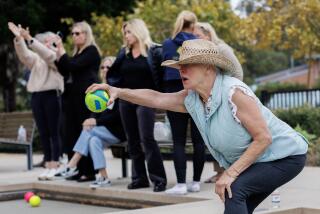DiMaggio’s Hometown Pitches Bocce, Not Baseball
- Share via
MARTINEZ, Calif. — This historic town on Carquinez Strait, 32 miles northeast of San Francisco, where John Muir hung his hat the last 24 years of his life, is the birthplace of the martini and Joe DiMaggio.
It’s also the bocce ball capital of America.
There are more players of the old Italian bowling game per square foot in Martinez, population 28,000, than anywhere else in the country. The town has the largest organized bocce league in the United States, 123 teams with more than 1,200 regular players.
Ken (Barbarossa) Dothee, 44, a local public defender and former Martinez City Councilman, is president of the U.S. Bocce Federation. His Italian nickname means Red Beard. He’s not Italian. He is of German descent.
United States Bocce, the official magazine of the game, is published here. Donna Allen, 45, like Dothee one of the town’s better players, is the publication’s editor. She works for the Contra Costa County Planning Commission. She isn’t Italian, either.
National bocce championships have been held in the U.S. since 1979. The first two were in Las Vegas and Denver, but little Martinez had the third national championship in 1981 on the 12 permanent hard-compacted oyster shell courts at the town’s Shoreline Park.
“Our courts make up the largest permanent bocce facility in America,” Dothee said. “There’s no other layout like this in America.”
Here, league play goes on during the day and under lights at night.
“Bocce was a game played traditionally by older gentlemen in Italian communities all over the U.S.,” Dothee said. “It caught on here in Martinez 15 years ago and the face of the sport hasn’t been the same since.”
Dothee said that men, women and children of all nationalities are playing the game now. New leagues are springing up all over, in California as well as the rest of the country.
Bocce dates to centuries before the birth of Christ. Julius Caesar and his soldiers lagged rocks at small target stones between campaigns. Bocce is the national sport of Italy and is popular as well in France, Switzerland, Yugoslavia and South America.
World championships have been held since 1950, with Italy winning most of the time. Dothee has accompanied the U.S. team to the world championships the last six years.
“Not as a player, but as a representative of the U.S. Bocce Federation,” he said. “I’m a pretty good lagger, but nowhere good enough to be on a national or world championship team.” He has attended the world championships in Split, Yugoslavia; Melbourne, Monaco, Milan, Buenos Aires and Valparaiso, Chile.
Milan played host to the world championships last October, when the best players from 24 nations competed. Players from five other countries--Morocco, Hungary, Luxembourg, Romania and the Soviet Union--planning to participate in this year’s tournament in Sao Paulo, Brazil, were on hand as observers at Milan.
The U.S. team finished 13th in Milan, winning more games than it had in any previous world championships. The U.S. team also finished ahead of France, Germany, Spain, Belgium, Canada and Brazil, among other countries.
Four players from Martinez have played in world competition in previous years--Nicolo Ditullio, Joe Avina, Tommy Balistrieri and Leo Moro.
Bocce was recently recognized by the International Olympic Committee and its proponents hope it will be included as a demonstration sport at the 1992 Barcelona Games.
“Andiamo, a giocare le bocce,” announces the “commish,” the team leader in Martinez when league play begins. It means, “Let’s go, friends, and play bocce.”
The courts at Shoreline Park are 85 feet long, 12 feet wide. The bocce is a wood composition or metal ball, softball-size, rolled down the court at a pallino or jack, the golf ball-size target ball. The object is to roll the bocce as close to the pallino as possible.
In team play, eight balls are used, two per competitor. Points are scored for each team’s throws closer to the pallino than the opponent’s. Players also try to knock the other team’s balls away from the pallino.
“In international play, a player will call his shot, designate which ball he wants to hit,” Dothee said. “The player runs up to a line and lofts the ball 60 to 70 feet through the air and must hit the pallino or an opponent’s ball on the fly. It’s like making a three-point basketball shot.”
He mentioned the Italian superstar of bocce, a player named Granaglia.
“He is the Babe Ruth of bocce, a man in his 50s, a living legend who . . . doesn’t need a first name. He has made over 100 consecutive airborne shots. Nobody else can do it like he can.”
The Pope is a bocce player. So is Rudy Perpich, the longtime governor of Minnesota.
And, says Allen, “People from all walks of life play bocce in Martinez. We have teams with four generations of the same family. We have all-women teams in addition to the all-men teams. Teams with husbands and wives, neighbors, co-workers, judges and garbage men, secretaries, cops, teachers, lawyers, doctors.”
Dothee, who spearheaded the bocce movement in Martinez, is a graduate of St. Mary’s College in nearby Moraga. He is trying to get St. Mary’s to become the first college in the country with bocce as a sponsored sport.
“As president of the U.S. Bocce Federation, established in 1977, my main job is to coordinate activities, to promote bocce, to get it accepted as a high school sport,” he said. “Bocce is in its adolescence in America. Our goal is to change that, to put it right up there with golf and tennis.”
Dothee was introduced to the game as a youngster.
“When I was a kid in San Francisco and rode my bike to the pier to go fishing, I’d pass the bocce courts on the waterfront. I was fascinated by the old men speaking a foreign language (Italian), bowling the balls and smoking cigars that smelled awful.”
Eventually, he took up the game himself and in 1975 he and several others formed the first league in Martinez with eight teams.
Cafe Romano on Martinez’s Main Street is the gathering place for bocce players and league officials. Downtown Martinez is a quaint, turn-of-the-century business section. The town is filled with Victorian homes. It was named after Don Ignacio Martinez, who had 11 children and 17,000 acres here when California was part of Mexico.
During the Gold Rush of 1848, miners would stop off in Martinez and drink something called the Martinez Special, a local concoction made of one part very dry sauterne wine and three parts gin. It was stirred in ice and finished with an olive. Over the years the Martinez Special became the martini special, then simply the martini.
Italian fishermen, including Joe DiMaggio’s father, arrived shortly after the Gold Rush and kept their fishing fleets here. There is a Joe DiMaggio street in Martinez and a Joe DiMaggio baseball park next to the bocce courts. Fisherman’s Park is named in honor of the Italian fishermen of Martinez and, appropriately, is on Berrellessa Street.
A famous Italian restaurant in Manhattan, Vagabondo, has had bocce courts for years. So has Bocce Cellar in Santa Cruz where, since the 1930s, enthusiasts have played on its two courts.
“We have to kick the players out nearly every night when the place closes at 2 a.m.,” says owner Larry Behman.
The San Francisco law firm of Coblentz, Cahen, McCabe & Breyer calls its bocce court on the seventh floor rooftop of their office building the highest bocce court on earth.
“The sport is a comer,” Allen said. “We estimate that at least 1 million Americans play the game.”
Said Al Milano, a Martinez surveyor: “Bocce is like abalone and calamari. (Once,) only the Italians knew about it. Now, it’s becoming popular all over the place.”
More to Read
Go beyond the scoreboard
Get the latest on L.A.'s teams in the daily Sports Report newsletter.
You may occasionally receive promotional content from the Los Angeles Times.










